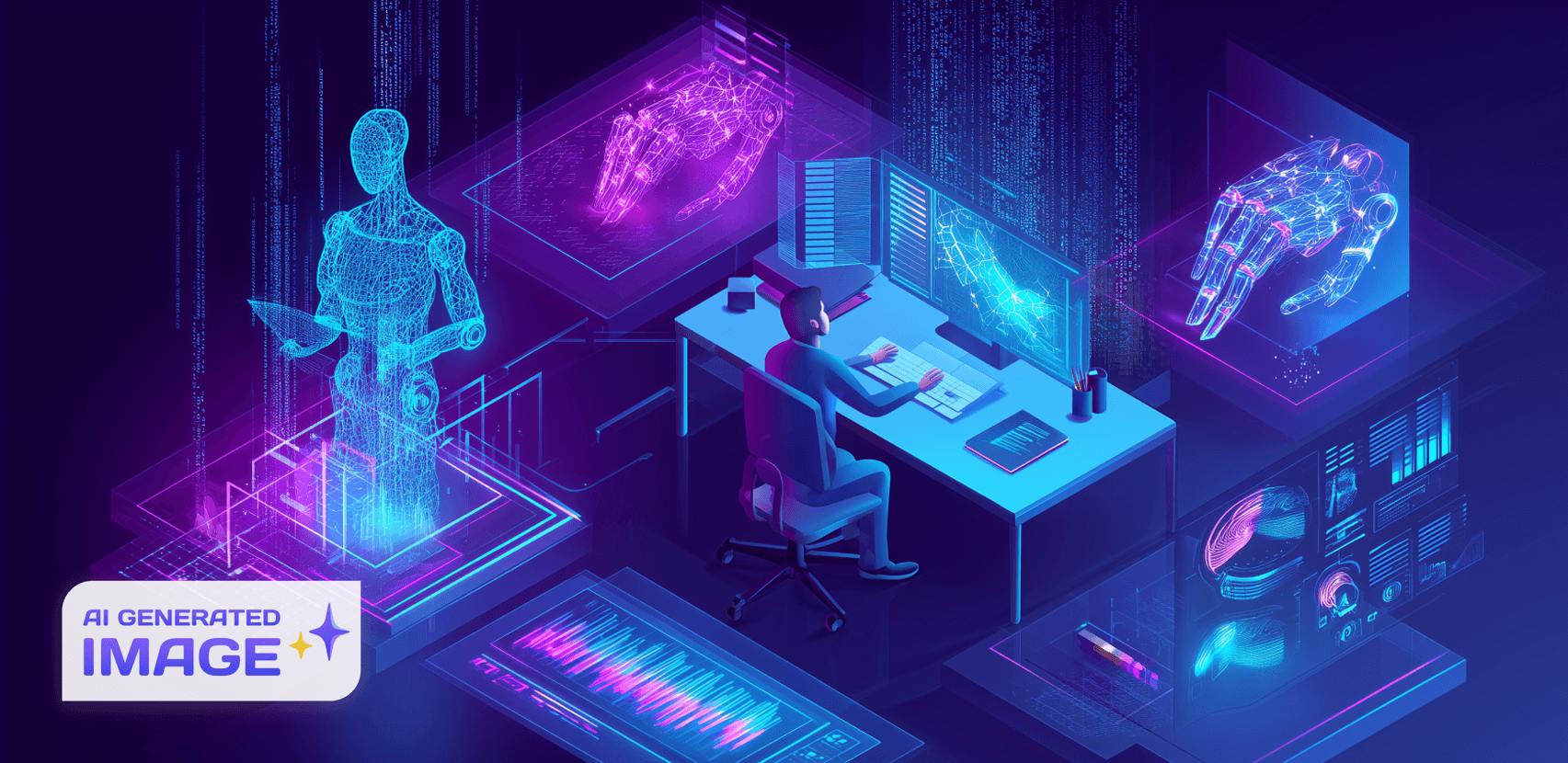2025 Guide: Agentic Systems with AI Augmentation

Table of Contents
- What is AI Augmentation?
- Benefits of AI Augmentation for Businesses
- Current Trends and Developments in AI Augmentation
- Challenges in Implementing AI Augmentation
- Ethical Considerations in AI Augmentation
- Frequently Asked Questions
- Conclusion
What is AI Augmentation?
AI augmentation refers to the strategic integration of artificial intelligence technologies to enhance human capabilities, rather than replace them. This approach leverages AI to support and amplify human performance across various domains, fostering a collaborative synergy between human intelligence and machine efficiency.
Core Concepts of AI Augmentation
- Cognitive Enhancement: AI systems assist in complex decision-making processes by analyzing vast datasets, identifying patterns, and providing insights that might be overlooked by humans alone. This collaboration leads to more informed and efficient outcomes.
- Workplace Integration: In professional settings, AI tools are designed to complement human skills, automating routine tasks and allowing individuals to focus on more strategic and creative endeavors. This partnership aims to boost productivity and job satisfaction.
- Educational Support: AI-driven platforms offer personalized learning experiences, adapting to individual student needs and providing tailored resources. This customization enhances engagement and facilitates deeper understanding of the material.
- Healthcare Advancements: In the medical field, AI augmentation aids in diagnostics, treatment planning, and patient monitoring, enabling healthcare professionals to deliver more accurate and timely care.
Key Insight: AI augmentation emphasizes collaboration between humans and machines, enhancing human abilities rather than replacing them.
By focusing on augmentation, AI technologies aim to empower individuals and organizations, fostering innovation and efficiency while preserving the essential human elements of creativity and critical thinking.
Benefits of AI Augmentation for Businesses
Artificial Intelligence (AI) augmentation is revolutionizing the business landscape by enhancing efficiency, reducing costs, and fostering innovation. A 2025 study indicates that 78% of organizations have integrated AI into at least one business function, marking a significant increase from 55% the previous year. (upwork.com)
Efficiency and Cost Reduction
AI technologies streamline operations by automating routine tasks, leading to substantial productivity gains. For instance, IBM reported $3.5 billion in productivity improvements since January 2023, attributing this to AI-driven automation. (mezzi.com) In the manufacturing sector, AI has accelerated product development cycles by 50% and reduced development costs by 30%, showcasing its potential to enhance operational efficiency. (mezzi.com)
Innovation and Competitive Advantage
AI fosters innovation by enabling businesses to develop new products and services. Generative AI, for example, has been instrumental in creating novel business models and value propositions. Research highlights that AI-driven innovation is reshaping traditional business paradigms, leading to the emergence of new market opportunities. (arxiv.org)
Case Studies of Successful AI Implementations
In the healthcare industry, AI applications have yielded a return of $3.20 for every dollar invested, driven by efficiencies in clinical operations and improved patient outcomes. (classicinformatics.com) Similarly, small businesses leveraging AI technologies are 1.6 times more likely to experience revenue growth of 5% or more, demonstrating AI’s impact across various business sizes. (zipdo.co)
Embracing AI augmentation equips businesses with the tools to enhance efficiency, reduce costs, and drive innovation, positioning them for sustained success in a competitive marketplace.
Current Trends and Developments in AI Augmentation
Emerging AI Technologies
Artificial Intelligence (AI) is rapidly transforming various sectors, with notable advancements in multimodal AI systems. These systems can process and interpret multiple data types - such as text, images, audio, and video - simultaneously, enhancing contextual understanding and decision-making capabilities. For instance, the Hawaii Department of Transportation has implemented a Climate Resilience Platform that leverages multimodal AI to assess climate risks and prioritize infrastructure investments effectively. (cloud.google.com)
In the public sector, AI adoption is accelerating. A 2025 report by the U.S. Government Accountability Office (GAO) indicates that the number of AI use cases in federal agencies nearly doubled from 571 in 2023 to 1,110 in 2024. Notably, generative AI applications increased approximately ninefold during this period, highlighting a significant shift towards more advanced AI implementations. (files.gao.gov)
Despite these advancements, AI adoption remains uneven across different regions and socioeconomic groups. Data from Anthropic reveals that wealthier countries and U.S. states exhibit higher AI usage rates compared to developing regions, underscoring the need for equitable access to AI technologies. (axios.com)
As AI continues to evolve, it is crucial to monitor these trends to ensure that technological advancements contribute positively across all sectors and communities.
Challenges in Implementing AI Augmentation
Integrating AI augmentation into business operations presents several challenges that organizations must navigate to achieve successful implementation.
Data Management Issues
Effective AI systems require high-quality, well-organized data. However, many organizations struggle with data silos, inconsistent formats, and incomplete datasets, which can impede AI performance. The Centers for Disease Control and Prevention (CDC) highlights the importance of robust data management in public health initiatives, emphasizing that poor data quality can lead to inaccurate analyses and outcomes. (cdc.gov)
Skills Gaps
The rapid advancement of AI technologies has outpaced the availability of skilled professionals. A 2024 study by the CDC’s National Institute for Occupational Safety and Health underscores the need for specialized training in AI applications to enhance public health surveillance. (stacks.cdc.gov)
Overcoming Barriers to Entry
- Invest in Data Infrastructure: Develop comprehensive data management systems to ensure data quality and accessibility.
- Enhance Workforce Capabilities: Implement training programs to equip employees with necessary AI skills.
- Foster Collaborative Partnerships: Engage with academic institutions and industry experts to stay abreast of AI developments and best practices.
By proactively addressing these obstacles, businesses can better position themselves to leverage AI augmentation effectively.
Ethical Considerations in AI Augmentation
The integration of artificial intelligence (AI) into business operations introduces significant ethical challenges that organizations must address to ensure responsible AI use. Key concerns include algorithmic bias, transparency, accountability, and the potential for unintended consequences.
Algorithmic Bias and Fairness: AI systems can inadvertently perpetuate existing biases present in their training data, leading to unfair outcomes. For instance, biased hiring algorithms may disadvantage certain demographic groups, reinforcing societal inequalities. Ensuring fairness requires meticulous data selection and continuous monitoring to detect and mitigate bias.
Transparency and Explainability: The complexity of AI models often results in “black box” systems, where decision-making processes are opaque. This lack of transparency can erode trust among stakeholders. Implementing explainable AI practices allows businesses to provide clear justifications for AI-driven decisions, fostering trust and accountability.
Accountability and Responsibility: Determining responsibility for AI-generated outcomes is crucial, especially when decisions have significant impacts. Organizations must establish clear accountability frameworks, ensuring that human oversight is maintained and that there are mechanisms to address errors or adverse effects.
Best Practices for Ethical AI
- Develop Ethical Guidelines: Create comprehensive policies outlining acceptable AI use, emphasizing fairness, transparency, and accountability.
- Conduct Regular Audits: Periodically review AI systems to identify and rectify biases or unintended consequences.
- Engage Stakeholders: Involve diverse groups in the AI development process to capture a wide range of perspectives and mitigate bias.
- Ensure Human Oversight: Maintain human involvement in critical decision-making processes to provide context and ethical judgment.
- Promote Transparency: Implement explainable AI techniques to make decision-making processes understandable to non-experts.
By adhering to these practices, businesses can navigate the ethical complexities of AI augmentation, ensuring that their AI initiatives are both effective and responsible.
Ready to take your next step in leveraging agentic systems and AI augmentation for your business? Jetpack Labs is here to help you transform complex ideas into high-performing digital products that stand out in today’s competitive landscape. Whether you’re a startup founder or leading a scale-up, our team specializes in custom software solutions, intuitive UX/UI, and robust digital strategies tailored to your unique needs. We understand the challenges of integrating AI and agentic systems, from strategy to secure implementation, and offer expert guidance every step of the way. Discover how our agile approach, quality code, and transparent partnership can accelerate your digital transformation and keep you ahead of the curve. Learn more about how our consultancy can refine your AI strategy and unlock new growth opportunities. Visit Jetpack Labs to see how we can help you build, scale, and succeed with confidence.
Frequently Asked Questions
Q1: What are agentic systems in AI augmentation?
Agentic systems are AI-driven frameworks designed to act autonomously, making decisions and taking actions to achieve specific goals. These systems combine advanced machine learning with reasoning and planning capabilities, enabling them to adapt to changing environments and user needs. According to Wikipedia, agentic AI can perceive its environment, process information, and execute actions independently, making them valuable for complex problem-solving in business and research.
Q2: How can organizations ensure ethical use of agentic AI systems?
Ensuring ethical use involves implementing transparent decision-making processes, regular audits, and clear accountability structures. Research from the European Commission highlights the importance of aligning AI systems with human values, privacy standards, and legal frameworks. Organizations should also provide ongoing training for staff and establish mechanisms for monitoring and addressing unintended consequences of AI deployment.
Agentic AI systems, characterized by their autonomous decision-making capabilities, are revolutionizing various sectors by enhancing efficiency and innovation. These systems can operate independently, adapting to dynamic environments and learning from new data, thereby offering expansive opportunities across industries. However, their deployment is not without challenges. Concerns such as algorithmic failures and the need for robust governance structures are paramount. Studies have shown that consumers may generalize failures from one AI system to others, potentially undermining trust in these technologies. (dl.acm.org) To navigate these complexities, adopting beginner-friendly strategies, such as incremental implementation and continuous monitoring, can mitigate risks associated with AI integration. Staying informed about emerging trends and ethical considerations is crucial for maintaining a competitive advantage in this rapidly evolving field. By proactively addressing these challenges, organizations can harness the full potential of agentic AI systems to drive innovation and operational excellence.
More of Our Starship Stories

Launching a Startup? Don't Run Out of Fuel!
February 13, 2025

Your AI Code Tool is a Glorified Junior Developer
December 20, 2024

Why Non-Tech Companies Are Quietly Winning With AI-Driven Software
April 9, 2025

